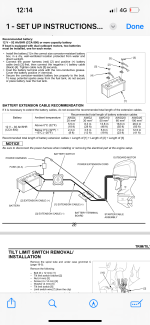T J Brodie
New member
Hi guys.
I have just joined this forum hoping to get answers or advice, as Honda Marine hasn’t exactly been helpful.
I’ve been having problems with a flat start battery since I re-powered with the new Honda BF225D in March 2022.
The Odyssey AGM OPS94R-850 start battery was new at the time of the install.
Both start & house batteries live on a Ctek MXS10 charger, apart from when I’m away at work, which is no longer than two weeks at a time.
This has left me scratching my head to why the start battery is often flat, as it should be more than capable of holding charge.
I have done some trouble shooting and found the DBW remote control box has a constant draw of 0.108 amps.
The DBW is hardwired to the positive terminal of the start battery (as per Honda wiring diagram attached) so this draw cannot be isolated.
Frequent discharge from this drain has pulled the voltage down too many times and the battery will no longer hold charge and is now unsafe to depend upon.
Can anyone out there confirm that this 0.108 amp current draw from the DBW remote control box is normal?
Or is there a problem that needs to be fixed?
Honda has advised me this is normal and no one else has had this problem, which I find hard to believe.
Look forward to a reply.
Cheers,
Tahl
I have just joined this forum hoping to get answers or advice, as Honda Marine hasn’t exactly been helpful.
I’ve been having problems with a flat start battery since I re-powered with the new Honda BF225D in March 2022.
The Odyssey AGM OPS94R-850 start battery was new at the time of the install.
Both start & house batteries live on a Ctek MXS10 charger, apart from when I’m away at work, which is no longer than two weeks at a time.
This has left me scratching my head to why the start battery is often flat, as it should be more than capable of holding charge.
I have done some trouble shooting and found the DBW remote control box has a constant draw of 0.108 amps.
The DBW is hardwired to the positive terminal of the start battery (as per Honda wiring diagram attached) so this draw cannot be isolated.
Frequent discharge from this drain has pulled the voltage down too many times and the battery will no longer hold charge and is now unsafe to depend upon.
Can anyone out there confirm that this 0.108 amp current draw from the DBW remote control box is normal?
Or is there a problem that needs to be fixed?
Honda has advised me this is normal and no one else has had this problem, which I find hard to believe.
Look forward to a reply.
Cheers,
Tahl


